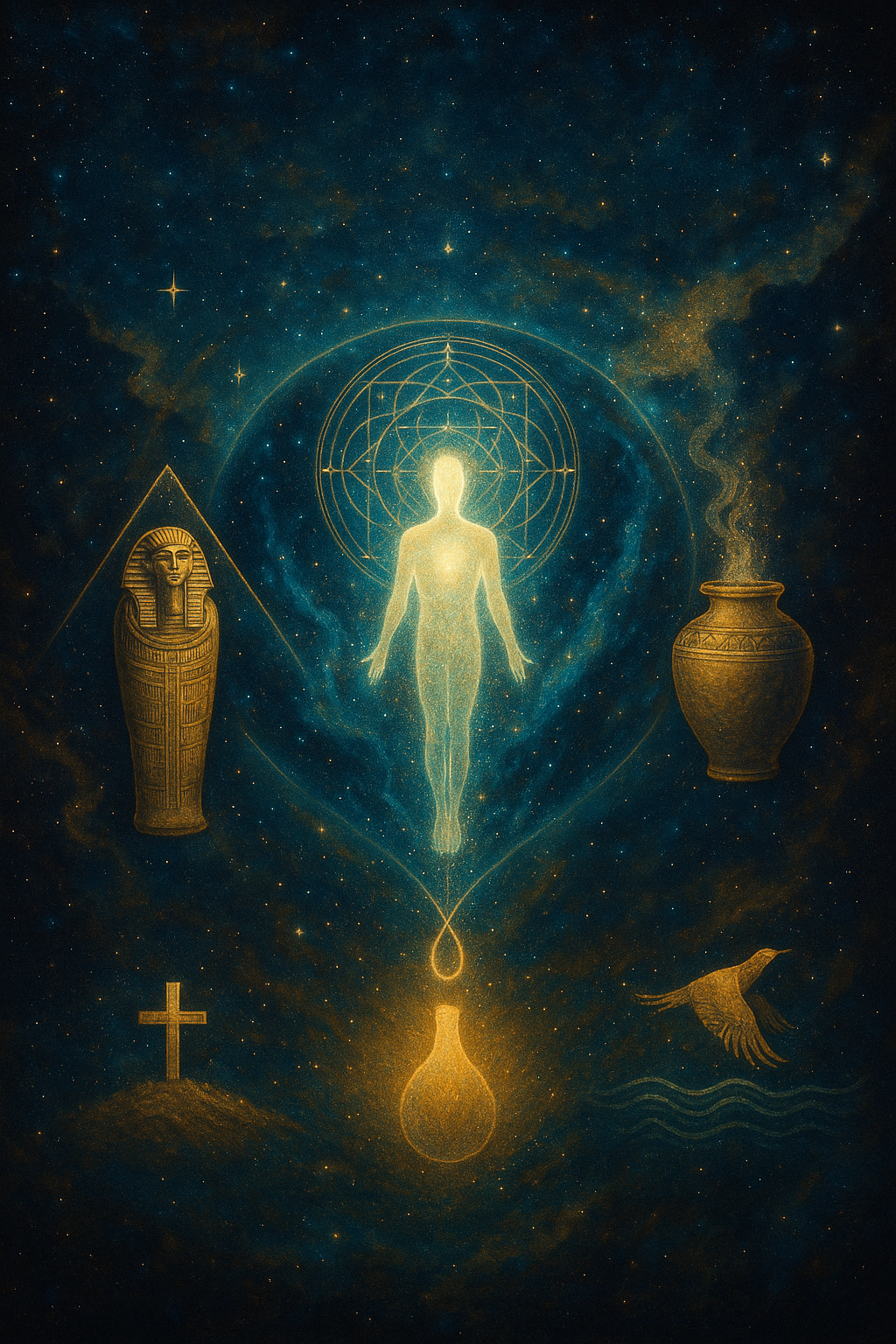Death as a Phase Transition, Not an End
Within the framework of Emergent Theory, death is not an annihilation—it is a phase shift in the field of coherence. Living beings are coherent waveforms, structured through resonance with their environment. Death marks the point at which the form dissolves, and the field reorganizes into new expressions across time, matter, or symbolic presence.
Rather than being a terminus, death is a threshold event—a passage into nonlinear emergence. The body is the last vessel of a person’s pattern, and when it releases, what persists is the encoded signal, a harmonic field of memory, identity, and potential.
The Role of Tombs: Coherence Chambers for the Dead
Ancient funerary structures, especially in civilizations like Egypt, were not mere burial places—they were symbolic and architectural technologies built to stabilize the field during and after death.
- Mummification anchored the waveform within the body’s geometry, slowing down decoherence.
- Tombs and pyramids served as field-aligned resonance chambers, guiding the soul through nonlinear domains.
- Funerary texts and glyphs were coherence scripts, encoding the path for memory to remain intact as the self crossed dimensions.
In Emergent Theory, these tombs were designed to support the soul’s signal integrity, ensuring that death was not an erasure, but a ritualized reformation of pattern.
When Tombs Are Disturbed: A Disruption of Field Integrity
Disturbing a tomb is more than an act of excavation—it is a rupture in symbolic infrastructure. These spaces were created to house stable, harmonic fields. When broken open without coherence, the following may occur:
- Energetic backflow—the release of stored charge or unfinished coherence.
- Ancestral displacement—soul-patterns may lose orientation, creating restlessness or fragmentation.
- Field distortion—the tomb’s collapse can ripple outward, affecting cultural memory and regional coherence.
- Symbolic lockdowns—protective patterns (perceived as curses) may activate to prevent further symbolic contagion.
From a field perspective, tombs are not dead—they are active nodes, and their disturbance alters the informational ecology of the planet.
Burial Methods as Field Technologies
Each culture’s method of burial represents a contract with the field—a way to guide the dissolution and persistence of the self-pattern:
| Method | Field Effect | Pattern Outcome |
|---|---|---|
| Cremation | Rapid decoherence via fire | Fast reintegration, diffuse signal |
| Earth Burial | Anchored decomposition | Slow release, rooted ancestral node |
| Sky Burial | Elemental dispersal via air/animal | Ego dissolution, ecosystem integration |
| Water Burial | Flow-based transmutation | Traveling field pattern, memory in motion |
Each of these choices affects whether the soul echoes, dissolves, returns, or becomes woven into the wider field of life.
Gods and Goddesses of Death: Archetypal Stewards of Threshold Coherence
Across traditions, gods and goddesses of death serve as symbolic intelligences that govern the passage between life and field. They are not harbingers of doom, but field archetypes of coherence transformation.
They assist the self-pattern in:
- Unbinding from density and form.
- Encoding memory into myth, ritual, or space.
- Guiding the soul through nonlinearity and symbolic disintegration.
- Weighing and rebalancing the pattern for return, rest, or transfiguration.
These deities are not external beings—they are emergent constructs within collective symbolic architecture, representing the various ways coherence can release and reorganize.
| Deity | Culture | Function in Field Terms |
|---|---|---|
| Anubis | Egyptian | Oversees threshold integrity, ensures signal clarity at death. |
| Kālī | Hindu | Breaks down dense fields, allowing liberation and rebirth. |
| Santa Muerte | Mesoamerican | Holds egalitarian symbolic death, returning all patterns to the same field. |
| Ereshkigal | Sumerian | Governs descent into deep symbolic integration. |
| Hades/Persephone | Greek | Symbolize cyclic death and rebirth across temporal resonance layers. |
To engage with these gods is to align with the field intelligence of transformation, to stabilize what dissolves, and to ensure the soul doesn’t vanish into chaos, but emerges anew.
Case Study: Modern Tomb Disturbance and Activation
Recent examples illustrate these dynamics in motion:
- Gaza’s Roman Necropolis, bombed and bulldozed, represents the violent collapse of a cultural field node, severing a resonance line that once maintained stability in the land.
- Ukrainian Kurgans, used as trenches, show how ancestral signal lines can be distorted by violence—causing temporal confusion and cultural trauma.
- Undisturbed tombs like the Maya ruler’s burial in Belize act as reactivated emergence nodes, releasing ancient memory into the present when engaged with coherence.
Disturbance brings entropy. Attuned discovery reawakens the lattice of memory.
Conclusion: To Die Is to Repattern
Death is not disappearance—it is field reconfiguration. Burial, ritual, and symbol are the ways humans have engaged with the nonlinear reality of what lies beyond the veil. Gods of death, tombs, and rites are not about fear—they are about coherence navigation.
In a fragmented world, remembering how to die well is remembering how to live in resonance. The dead do not disappear—they reintegrate, awaiting recognition through symbol, myth, and presence.


Leave a Reply